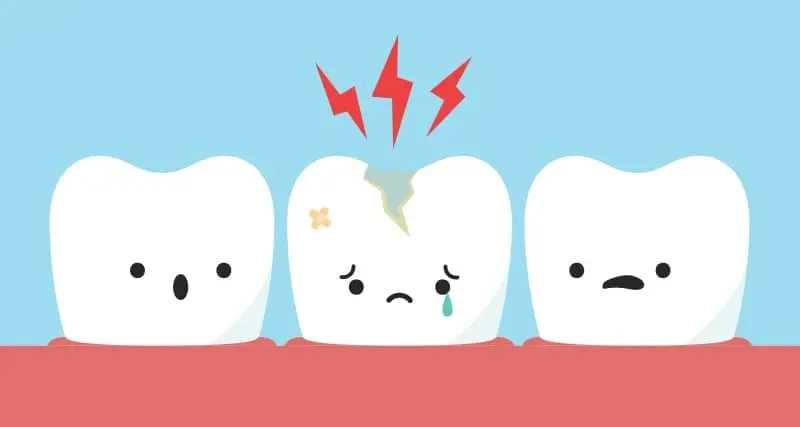Although you might not think of teeth as living things, healthy teeth are very much alive. As such, despite the numerous stresses and strains that our teeth must withstand, they can chip, crack, or even break.
These fractures are frequently caused by:
eating a tough meal
facial injuries after an accident
harm caused by sports
Untreated cavities
The natural tooth’s remaining structure may eventually become fragile. Damaged teeth may not always hurt right away. If the break has reached the nerve, you might occasionally feel uncomfortable when chewing or be sensitive to heat and cold. Whether you are in pain or not, your dentist should look into any breaks as soon as possible to assess the tooth's health and viability and to administer any essential therapy to stop any deterioration or issues.
Your damaged teeth can either be identified as dead teeth, chipped teeth, broken teeth, and even cracked teeth.
Dead Teeth
A tooth that is no longer receiving new blood is said to be dead. One of the early indicators of a failing tooth for many people may be discoloration. Gum or tooth discomfort is another possibility.
Your dying tooth will be a different hue from the rest of your teeth if it has a discolored tooth. Yellow, light brown, gray, or even black are all possible colors for dying teeth. The tooth may appear to be bruised almost. As the tooth continues to deteriorate and the nerve dies, the discoloration will get worse over time.
Another potential sign is pain. Some inpiduals experience no pain at all. Some people experience minor discomfort, while others experience severe discomfort. The dying nerve and a potential infection are frequently to blame for this discomfort.
It’s crucial to schedule an immediate appointment with your dentist if you notice any signs that a tooth is dying.
Chipped Teeth
Save the chipped part if you find it. But it's okay if you don’t; dentists can now repair the tooth using white resins. If you're lucky, only a tiny fragment of enamel was damaged. In most cases, a single visit to the dentist can fix it. A crown that covers the remaining portion of the broken tooth may be necessary for a larger chip. You will require at least two visits since the dentist needs to make an impression of the tooth in order to mold the crown. You'll only require a root canal, which entails removing the pulp and replacing it with gutta percha, a type of plastic filling, if there is potential sign of infection.1
Broken Teeth
As these issues may be caused by a cavity, severely shattered and cracked teeth may need more involved procedures. Large cavities are uncomfortable if left untreated and can lead to fractures and breaks. Infections can result from tooth decay in the pulp and exposed gum line (root canal, nerves and connective tissue). These situations might necessitate root canal therapy. Your nerve endings may also be exposed by cracks and breaks, making your teeth more sensitive to meals, air, and temperature changes.
Cracked Teeth
When a crack develops in your tooth, it is known as a fractured tooth, also known as cracked tooth syndrome (CTS). Sometimes the crack will be little and not harmful. Sometimes it can lead to a split or break in your teeth. Although anyone can crack a tooth, children and the elderly are more prone to tooth fractures. The location and degree of the fracture determine the course of treatment for a broken tooth. Visit a dentist right away if you think you have a broken tooth.2
What to Do if your Tooth is Damaged?
Before scheduling a visit with your dentist, follow these instructions if you’ve fractured or broken a tooth.
Rinse with warm water
Using gauze or a damp teabag, apply pressure to any spots that are bleeding.
If your cheek is swollen, apply an ice pack.
Cover any significant cracks with temporary dental cement if you have access to it.
Use paracetamol or another over-the-counter pain medication if it hurts (unless you are advised otherwise by your general doctor)
Any cracked teeth should be covered in milk, saliva, or saline solution.
Make sure not to brush your fractured teeth and schedule an appointment with your dentist right away.
Can Teeth Damage be Prevented?3
Yes, fortunately, you can prevent tooth damage! Follow the preventative measures below to achieve utmost care:
Brush your teeth twice a day with fluoride toothpaste, and floss your teeth every day to maintain good oral health. Don’t forget to use mouthwash twice a day. Mouthwash is an essential component of your routine.
Use a fluoride toothpaste and brush your teeth to ensure that you are receiving enough fluoride, also make sure you use a fluoride-based mouthwash.
Make wise dietary decisions by limiting your intake of meals and beverages that are heavy in sugars and carbs. Eat a variety of balanced, healthy meals and avoid snacking.
Avoid tobacco products, including the smokeless varieties.
Visit a dentist for routine examinations and expert cleanings.
To conclude, nothing compares to the way your natural tooth looks, feels, and works. You may prolong the life of your teeth by consistent brushing and flossing as well as six-month dental checkups. Your teeth may occasionally need special care if they are infected or are at risk of any disease. Treatments that keep your teeth healthy should constantly be taken into consideration. Also, make sure you invest in dental care products!
